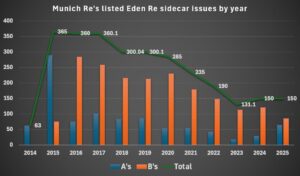PERILS with CRESTA CLIX to simplify reporting for cat bond & ILW risk transfer: CEO

Last year, catastrophe data aggregator and industry loss estimate provider PERILS revealed an extension to its services, with a new methodology that combines its standard data methodology with that of CRESTA CLIX, which the firm’s CEO Christoph Oehy has said will simplify the process for risk transfer use-cases including catastrophe bonds and ILW’s.
Back in November, when announcing its first loss estimate for the Storm Boris related severe flooding experienced across parts of Central Europe in September 2024, PERILS also revealed this change to its methodology offerings.
That loss event estimate was the first where it combined its own methodology with that of CRESTA CLIX, another loss data service owned by PERILS.
The standard PERILS approach, now renamed PERILS CORE, involves collecting catastrophe event loss data from affected insurers which is then grossed up to 100% market level to be reported on.
The CRESTA CLIX methodology is different, being based on the expert evaluation of a wide range of insurance industry sources, but as a result it covers a much wider range of territories than PERILS CORE.
With the combination of the two under a new catastrophe loss reporting methodology named PERILS EXTENDED, the company can from offer loss estimates all over the world from January 1st 2025, except for the United States.
Having provided its last quarterly update yesterday, the CRESTA CLIX service has now become part of the PERILS product offering as PERILS EXTENDED, from January 1st 2025, complementing the existing and now called PERILS CORE service.
Christoph Oehy, CEO of PERILS, commented on the change, “In the past years, industry losses reported by CRESTA CLIX have been used as triggers in ILW transactions and in one Cat Bond, in addition to industry losses reported by PERILS.
“Moving forward, by having a single reporting agency this will greatly simplify this process for the risk transfer markets, which was a key consideration when we decided to combine the two reporting services under the PERILS umbrella.”
Matthias Saenger, Manager at CRESTA CLIX, added, “We are proud of what we have achieved with CRESTA CLIX since the service was launched in 2020. The database now contains industry loss information for more than 200 catastrophe events. The data has been regularly reviewed and updated, and is accessible in a clean and structured format, allowing underwriters and Cat researchers to focus on analytics rather than data cleansing.
“The CLIX team is looking forward to the launch of the PERILS EXTENDED service and we are convinced that the merger with PERILS CORE will benefit our users as it will provide single-source access to a comprehensive industry loss database.”
For PERILS, the combination with CRESTA CLIX means the company can provide a much broader range of catastrophe insurance market loss estimates, will have a larger and wider-reaching catastrophe loss database, and has greatly enhanced its territorial coverage for industry loss estimate provision.
As we had said before, we suspect the move will have been in part driven by market feedback, suggesting the industry wants access to more loss estimates with a methodology behind them, but is also perhaps more open to different types of loss estimate methodologies than might have been assumed.
We had also noted that, while this enhances the utility of the service and bring new loss estimates to risk transfer market participants, the new methodology may not always meet users needs given the introduction of expert evaluation into the mix, rather than a reported loss data approach.
As we’ve always said in our reporting, more data is naturally beneficial to those looking to structure and trade industry-loss triggered instruments, such as catastrophe bonds and industry-loss warrants (ILWs) and can open up new risk transfer opportunities where before they had not been feasible.
It will be interesting to see whether the new combined methodology from PERILS and CRESTA can drive greater use of these industry-loss index based risk transfer instruments over time.






